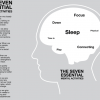http://www.ncbi.nlm....pubmed/20655484
The roles of GABAB receptors in cortical network activity.
...
In contrast, we have only recently begun to appreciate the roles of slow inhibition via GABA(B) receptors in the control of cortical network activity. Here, we provide a framework for understanding the contributions of GABA(B) receptors in helping mediate, modulate, and moderate different types of physiological and pathological cortical network activity. We demonstrate how the slow time course of GABA(B) receptor-mediated inhibition is well suited to help mediate the slow oscillation, to modulate the power and spatial profile of gamma oscillations, and to moderate the relative spike timing of individual neurons during theta oscillations. We further suggest that GABA(B) receptors are interesting therapeutic targets in pathological conditions where cortical networkactivity is disturbed, such as epilepsy and schizophrenia.
So Gaba B receptors modulate the cortical network... Hmm wonder if there have been any nootropic related findings here.
Hmm... Looking around Gaba B agonists have serious addiction and side effect issues, so not going to go there.
Maybe we should go back and look at glutamate again in the dAAC:
Oh wow look what we got from June 2012!
Eur J Pharmacol. 2012 Jun 15;685(1-3):59-69. Epub 2012 Apr 20.
A novel glycine transporter-1 (GlyT1) inhibitor, ASP2535 (4-[3-isopropyl-5-(6-phenyl-3-pyridyl)-4H-1,2,4-triazol-4-yl]-2,1,3-benzoxadiazole), improves cognition in animal models of cognitive impairment in schizophrenia and Alzheimer's disease.
Harada K, Nakato K, Yarimizu J, Yamazaki M, Morita M, Takahashi S, Aota M, Saita K, Doihara H, Sato Y,Yamaji T, Ni K, Matsuoka N.
Source
Pharmacology Research Labs., Astellas Pharma Inc., 21 Miyukigaoka, Tsukuba, Ibaraki 305-8585, Japan. katsuya.harada@jp.astellas.com
Abstract
Hypofunction of brain N-methyl-d-aspartate (NMDA) receptors has been implicated in psychiatric disorders such as schizophrenia and Alzheimer's disease. Inhibition of glycine transporter-1 (GlyT1) is expected to increase glycine, a co-agonist of the NMDA receptor and, consequently, to facilitate NMDA receptor function. We have identified ASP2535 (4-[3-isopropyl-5-(6-phenyl-3-pyridyl)-4H-1,2,4-triazol-4-yl]-2,1,3-benzoxadiazole) as a novel GlyT1 inhibitor, and here describe our in vitro and in vivo characterization of this compound. ASP2535 potently inhibited rat GlyT1 (IC(50)=92 nM) with 50-fold selectivity over rat glycine transporter-2 (GlyT2). It showed minimal affinity for many other receptors except for μ-opioid receptors (IC(50)=1.83 μM). Oral administration of ASP2535 dose-dependently inhibited ex vivo [(3)H]-glycine uptake in mouse cortical homogenate, suggesting good brain permeability. This profile was confirmed by pharmacokinetic analysis. We then evaluated the effect of ASP2535 on animal models of cognitive impairment in schizophrenia and Alzheimer's disease. Working memory deficit in MK-801-treated mice and visual learning deficit in neonatally phencyclidine (PCP)-treated mice were both attenuated by ASP2535 (0.3-3mg/kg, p.o. and 0.3-1mg/kg, p.o., respectively). ASP2535 (1-3mg/kg, p.o.) also improved the PCP-induced deficit in prepulse inhibition in rats. Moreover, the working memory deficit in scopolamine-treated mice and the spatial learning deficit in aged rats were both attenuated by ASP2535 (0.1-3mg/kg, p.o. and 0.1mg/kg, p.o., respectively). These studies provide compelling evidence that ASP2535 is a novel and centrally-active GlyT1 inhibitor that can improve cognitive impairment in animal models of schizophrenia and Alzheimer's disease, suggesting that ASP2535 may satisfy currently unmet medical needs for the treatment of these diseases.
Copyright © 2012 Elsevier B.V. All rights reserved.
So improving glycine availability by inhibiting the transporter improved NMDA receptor function which leads to better working memory.
How do we increase glycine availability?
Maybe just taking it straight? Is this safe?
http://en.wikipedia....eurotransmitter
...
There is some evidence showing that 3000 milligrams of glycine before bedtime improves sleep quality.[15]....
Animal and human foods
Other markets for USP grade glycine include its use an additive in pet food and animal feed. For humans, glycine is sold as a sweetener/taste enhancer. Food supplements and protein drinks contain glycine. Certain drug formulations include glycine to improve gastric absorption of the drug....
So it's used in foods and just checking around it appears to be a pretty common unremarkable supplement.
Let's see if we can find more evidence for glycine's health benefits...
Well they fed high dosages to rats and watched for excito-toxicity and didn't find any:
http://www.ncbi.nlm....pubmed/11343684
Chronic high-dose glycine nutrition: effects on rat brain cell morphology.
Shoham S, Javitt DC, Heresco-Levy U.
AbstractBACKGROUND:
Source
Research Department, Ezrath Nashim-Herzog Memorial Hospital, Jerusalem, Israel.
Facilitation of N-methyl-D-aspartate (NMDA) receptor-mediated neurotransmission via administration of glycine site agonists of the NMDA receptor (e.g., glycine, D-serine), and glycine transport inhibitors may represent an innovative pharmacologic strategy in schizophrenia; however, given the potential involvement of NMDA receptors in the neurotoxicity of excitatory amino acids, possible neurotoxic effects of glycinergic compounds need to be explored. Furthermore, studying brain adaptations to chronic administration of glycine site agonists may provide insights into the therapeutic mechanisms of these drugs.METHODS:
Adult rats were randomized to one of three nutritional regimens (no glycine supplementation, 1 g/kg/day, or 5 g/kg/day glycine supplementation) and to one of three treatment durations (1, 3, or 5 months). Serum glycine and serine levels at sacrifice and brain sections were examined using histologic markers of neurodegeneration (cresyl violet and silver impregnation staining) and immunohistochemical staining of glial fibrillary acidic protein, microtubule-associated protein, and neurofilament 200. To explore additional neural adaptations to high-dose glycine treatment, immunostaining was also performed for class B, N-type Ca(2+) channels.RESULTS:
Serum glycine levels increased dose dependently during glycine nutrition, whereas serine levels were not changed. In hippocampal dentate gyrus, the percentage of hypertrophied astrocytes transiently increased at 1 month. At 3 and 5 months of glycine treatment, the density of class B, N-type Ca(2+) channels was reduced in parietal cortex and hippocampus. No evidence of neuronal or glial cell excitotoxic damage or degeneration was registered at either of the treatment intervals studied.CONCLUSIONS:
These findings demonstrate for the first time that in vivo administration of high-dose glycine may induce brain morphological changes without causing neurotoxic effects. A reduction in density of class B, N-type Ca(2+) channels in specific brain regions may represent one general adaptation to long-term, high-dose glycine treatment.
Notice that they were giving 1g/kg dosages or 5g/kg dosages. Which are HUGE and no evidence of excitotoxicity.
What are Class B, N-Type Ca(2+) Channels anyway?
http://en.wikipedia....calcium_channel
These control the release of neurotransmitters. Blockade of which is being considered as a potential treatment for alcoholism.
They also had astrocyte hypertrophy. Which means enlargment of astrocytes which are gilial cells around the brain.
http://www.ncbi.nlm....pubmed/22046366
Here, we show that aerobic exercise at mid-age decreased markers of unhealthy brain aging including astrocyte hypertrophy , a hallmark of brain aging.
So not good.
So anyway... Taking 1g/kg or 5g/kg of Glycine is not something I'm going to do. The LD50 is roughly 7g/kg so these are huge doses they were giving these mice for months. However, it looks like a reasonable thing for me to test at normal supplement dosages (e.g 3g daily or less).
Searching around the forum found these cautions about glycine supplements in certain individuals.
http://www.longecity...ion-to-glycine/
That's why it's generally good practice to start with low dosages when taking new supplements.
Apparently your average can of Tuna has roughly 1g of glycine in it.
http://www.dietandfi...-in-glycine.php
Edited by abelard lindsay, 10 July 2012 - 03:59 AM.























































